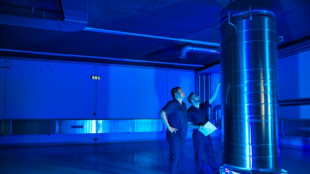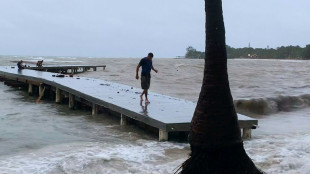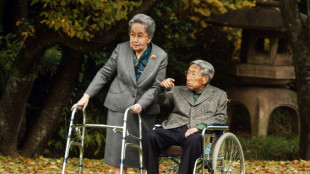
-
 Dinosaur skeleton fetches 6 million euros in Paris sale
Dinosaur skeleton fetches 6 million euros in Paris sale
-
Trump's Republican allies tread lightly on Paris pact at COP29

-
 China's Xi urges APEC unity in face of 'protectionism'
China's Xi urges APEC unity in face of 'protectionism'
-
Farmers target PM Starmer in protest against new UK tax rules

-
 UN climate chief urges G20 to spur tense COP29 negotiations
UN climate chief urges G20 to spur tense COP29 negotiations
-
Philippines warns of 'potentially catastrophic' Super Typhoon Man-yi

-
 Tens of thousands flee as Super Typhoon Man-yi nears Philippines
Tens of thousands flee as Super Typhoon Man-yi nears Philippines
-
Gabon votes on new constitution hailed by junta as 'turning point'

-
 Tens of thousands flee as Typhoon Man-yi nears Philippines
Tens of thousands flee as Typhoon Man-yi nears Philippines
-
Is Argentina's Milei on brink of leaving Paris climate accord?

-
 Fitch upgrades Argentina debt rating amid economic pain
Fitch upgrades Argentina debt rating amid economic pain
-
Trump picks Doug Burgum as energy czar in new administration

-
 At summit under Trump shadow, Xi and Biden signal turbulence ahead
At summit under Trump shadow, Xi and Biden signal turbulence ahead
-
Xi warns against 'protectionism' at APEC summit under Trump cloud

-
 Xi, Biden at Asia-Pacific summit under Trump trade war cloud
Xi, Biden at Asia-Pacific summit under Trump trade war cloud
-
Leftist voices seek to be heard at Rio's G20 summit

-
 Boeing strike will hurt Ethiopian Airlines growth: CEO
Boeing strike will hurt Ethiopian Airlines growth: CEO
-
US retail sales lose steam in October after hurricanes

-
 Spate of child poisoning deaths sparks S.Africa xenophobia
Spate of child poisoning deaths sparks S.Africa xenophobia
-
Comedian Conan O'Brien to host Oscars

-
 Gore says 'absurd' to hold UN climate talks in petrostates
Gore says 'absurd' to hold UN climate talks in petrostates
-
Global stocks struggle after Fed signals slower rate cuts

-
 China tests building Moon base with lunar soil bricks
China tests building Moon base with lunar soil bricks
-
Oil execs work COP29 as NGOs slam lobbyist presence

-
 Gore says climate progress 'won't slow much' because of Trump
Gore says climate progress 'won't slow much' because of Trump
-
'Megaquake' warning hits Japan's growth

-
 Stiff business: Berlin startup will freeze your corpse for monthly fee
Stiff business: Berlin startup will freeze your corpse for monthly fee
-
Dominican Juan Luis Guerra triumphs at 25th annual Latin Grammys

-
 Tropical Storm Sara pounds Honduras with heavy rain
Tropical Storm Sara pounds Honduras with heavy rain
-
TikTok makes AI driven ad tool available globally

-
 Japan growth slows as new PM readies stimulus
Japan growth slows as new PM readies stimulus
-
China retail sales pick up speed, beat forecasts in October

-
 Pakistan's policies hazy as it fights smog
Pakistan's policies hazy as it fights smog
-
Mexico City youth grapple with growing housing crisis

-
 Cracks deepen in Canada's pro-immigration 'consensus'
Cracks deepen in Canada's pro-immigration 'consensus'
-
Japan's Princess Mikasa, great aunt to emperor, dies aged 101

-
 Venezuela opposition activist dies in custody
Venezuela opposition activist dies in custody
-
Policymakers defend Fed independence amid concerns about Trump era

-
 Lebanon economic losses top $5 billion in year of clashes: World Bank
Lebanon economic losses top $5 billion in year of clashes: World Bank
-
Fed Chair calls US the best-performing major economy in the world

-
 Brother of late Harrods owner also accused of sexual violence: BBC
Brother of late Harrods owner also accused of sexual violence: BBC
-
New York to revive driver congestion charge plan, drawing Trump ire

-
 China's Xi arrives in Peru for APEC summit, Biden meeting
China's Xi arrives in Peru for APEC summit, Biden meeting
-
Spain's Vanguardia daily to stop posting on 'disinformation network' X

-
 New York to revive driver congestion charge plan
New York to revive driver congestion charge plan
-
US stocks wobble as traders weigh future Fed cuts

-
 BHP, Vale cleared by Brazil court over 2015 dam disaster
BHP, Vale cleared by Brazil court over 2015 dam disaster
-
Legal migration to OECD reaches new record in 2023

-
 Central bank independence 'fundamental' for good policy: Fed official
Central bank independence 'fundamental' for good policy: Fed official
-
EU fines Meta $840 million for 'abusive' Facebook ad practices


Myanmar rebels take the road to Mandalay
Winding through the lawless, rugged hills of northern Myanmar, National Highway 3 links a stunning series of victories by ethnic rebels and pro-democracy fighters in their war against the junta.
An offensive launched a year ago Sunday has seen opponents of the military seize much of the 480-kilometre-long (300-mile) route that connects second city Mandalay to China, Myanmar's biggest trade partner.
Control of the road denies the junta lucrative taxes, threatens its bases in the central plains, and is a huge morale booster for its opponents as the civil war grinds through its fourth year.
AFP images from National Highway 3 show the destruction wrought by the previous year's fighting and rebel groups trying to administer their newly seized territory.
The route begins at Muse, a town of ill-repute pressed up against the border with China.
Each morning, hundreds of locals queued for day passes to cross into China to buy medicine and consumer goods that can be re-sold back in Myanmar.
More than $2 billion worth of trade passed through Muse in the 2023-2024 financial year, according to the junta's commerce ministry. Analysts say much more goes through off the books.
But following the rebels' spectacular advance, venturing into the hinterland from Muse requires some savvy -- and cash -- said Aung Gyi, a driver.
"We're OK if we can negotiate when we meet with ethnic rebel soldiers on roads and they ask for money," he said, asking to use a pseudonym.
Around an hour from Muse was a checkpoint manned by soldiers from the Ta'ang National Liberation Army (TNLA), one of the rebel groups behind last year's offensive.
- 'Fighting up and close' -
Around 30 kilometres further on is the town of Kutkai, infamous for the production of methamphetamine and normally home to around 50,000 people.
The fighting that has pushed the military out has scattered many of its residents and scarred the town.
Rubble littered across an open patch of ground was all that remained of the main market, flattened by a military airstrike.
Nearby, vendors had set up makeshift bamboo stalls to sell medicine and clothes.
"In northern Shan, the sound of gunfire is not very strange for us," said resident Soe Naung, asking to use a pseudonym.
"But when we saw the fighting up close in our town, we were very afraid. We witnessed it with our own eyes.
"We can only hope our city will revive if the national highway opens again. Now our daily lives are full of fear about air strikes."
In Kutkai, highway traffic consisted mostly of motorbikes laden with goods wrapped in tarpaulins.
Two young police officers in ethnic rebel uniforms sat on plastic chairs by the roadside and watched the traffic go by.
- Burma Road -
Roughly halfway along the highway, the city of Lashio embodies the biggest defeat the junta has suffered since it seized power in 2021.
Its four-lane toll gate was riddled with bullet holes and several panels were hanging loose, remnants of fierce fighting for the city where around 150,000 people lived before the offensive.
Lashio was famous as the terminus of the "Burma Road" built by the British usng local labour to supply Chinese forces battling Japanese invaders during the Second World War.
Now it is the prize of the Myanmar National Democratic Alliance Army (MNDAA), an ethnic Chinese rebel group, whose red and blue flags flutter over its pockmarked buildings.
A spiked black gate bears the name of a military engineering unit that was chased from the city.
On another street, two men were fixing electricity pylons.
The MNDAA is working to install a civilian administration it hopes will tempt residents to return to the city.
The military is trying to keep people away, and on Wednesday launched its latest airstrike on Lashio, according to local media and a rescue group.
- Hill station -
Near the end of National Highway 3, the former British hill station of Pyin Oo Lwin is still in the hands of the military.
The road passes grand houses of teak and brick and the military's elite officer training academy.
"We also hear shooting sounds here sometimes," said one female vendor at the town's bustling market.
A two-hour drive down into the dusty plains places you in the former royal capital of Mandalay and the end of the highway.
Targeting the city of 1.5 million is the "Mandalay People's Defence Force," which fought alongside the ethnic rebels in the Shan hills during the past year.
In August, the "Mandalay PDF" hailed the bonds its fighters now shared with Shan state, forged in battle against the military along "National Highway 3."
"Now, the dream of a day trip for Shan noodles is coming true," it said in a statement, referencing a popular local dish from the region.
H.Meyer--CPN
